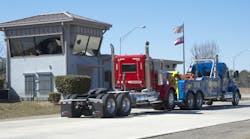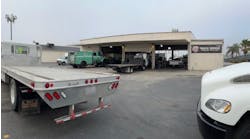There are several indubitable facts of operating a fleet:
- Breakdowns surely will occur.
- Roadside service calls – which every fleet maintenance manager dreads getting – are expensive and time consuming.
- Unscheduled downtime is particularly unproductive and costly.
Based on the industry rule of thumb, large trucks and tractor trailers will have one emergency breakdown a year, according to Ryder System, a provider of commercial transportation, logistics and supply chain management solutions. “At an estimated cost of $1,000 per breakdown, breakdowns are disruptive, costly and can compromise delivery schedules, commitments and product safety.”
What’s more, breakdowns also can be dangerous, they add, as “idle drivers and vehicles are exposed to the dangers of drivers who are distracted or traveling at high speeds.”
Under Control
Could you have prevented the breakdown? Are issues identified beforehand and then addressed so that a roadside service call can be prevented?
The answers depend on a number of things:
- How good are your routine scheduled preventive maintenance (PM) programs and services?
- Do you keep track of what PMs, services and repairs are due for what vehicles and when? Do you get them done on schedule?
- Are maintenance and repairs performed properly the first time so there won’t be comebacks or issues down the road?
- While a truck is in the shop for service, are any additional repairs made so the truck won’t have to go back to the shop several times?
- Are there similar issues across a make and model of truck that indicate there might be a problem?
- Do you know the most common reasons for your breakdowns?
- Are your shops set up and organized for efficiency to get vehicles in and out rapidly?
- Are your drivers properly conducting pre- and post-trip vehicle inspections?
By identifying equipment defects and safety issues, they can be dealt with before they cause failures, thus preventing pricy roadside repairs, unexpected downtime, possible fines, CSA (Compliance, Safety, Accountability) violations and an out-of-service event.
Keep in mind Ben Franklin’s observation: “An ounce of prevention is worth a pound of cure.” It is far better to try to and keep a breakdown from happening than it is to have to deal with getting a vehicle back up and running as quickly as possible. No easy task, especially when dealing with outside vendors.
Too Much Information
Fleets use a variety of recordkeeping methods – including telematics, remote diagnostics and computerized maintenance management systems (CMMS) – to enable their maintenance managers to better plan, manage, record and communicate day-to-day vehicle maintenance activities and operations. Plus, these tools help maximize the use of resources – manpower, equipment and material – to optimize parts inventories, improve CSA compliance, control costs and keep equipment on the road.
Recordkeeping methods gather an excessive amount of information, and they do it constantly. Maintenance managers are bombarded with an endless stream of alerts, tweets, texts, emails, reports, analyses, etc.
“In the business world, employees spend approximately 60 percent of their time processing informational documents,” wrote Marsha White and Steve M. Dorman in their article, Confronting Information Overload, which appeared in the Journal of School Health. “A typical manager reads 1 million words every week, a word total equal to one and a half full-length novels a day.”
While information is a valuable resource, the authors warn that “uncontrolled, unorganized and excessive information can hinder learning, decision making and well-being.”
“Simply put, information overload is when our ability to process information has passed its limit, and further attempts to process information or make accurate decisions from the surplus of information leads to information overload,” adds Steve Nguyen, Ph.D. – a leadership and talent consultant.
Mine Data
What can be done? Sift through the collected information to gain even better control of the maintenance operation, identify root causes of problems and issues and find insights to make your maintenance operation more productive.
A recent tool developed to help with these objectives is data mining, also known as Knowledge Discovery in Data (KDD). “Data mining is the practice of automatically searching large stores of data to discover patterns and trends that go beyond simple analysis,” explains Oracle, a company that offers Cloud applications and platform services. “Data mining uses sophisticated mathematical algorithms to segment the data and evaluate the probability of future events.”
The overall objective is to focus on solving problems by taking proactive action instead of chasing them. Finding solutions will result in improved maintenance activities and operations. That means fewer breakdowns and/or unscheduled service events.




